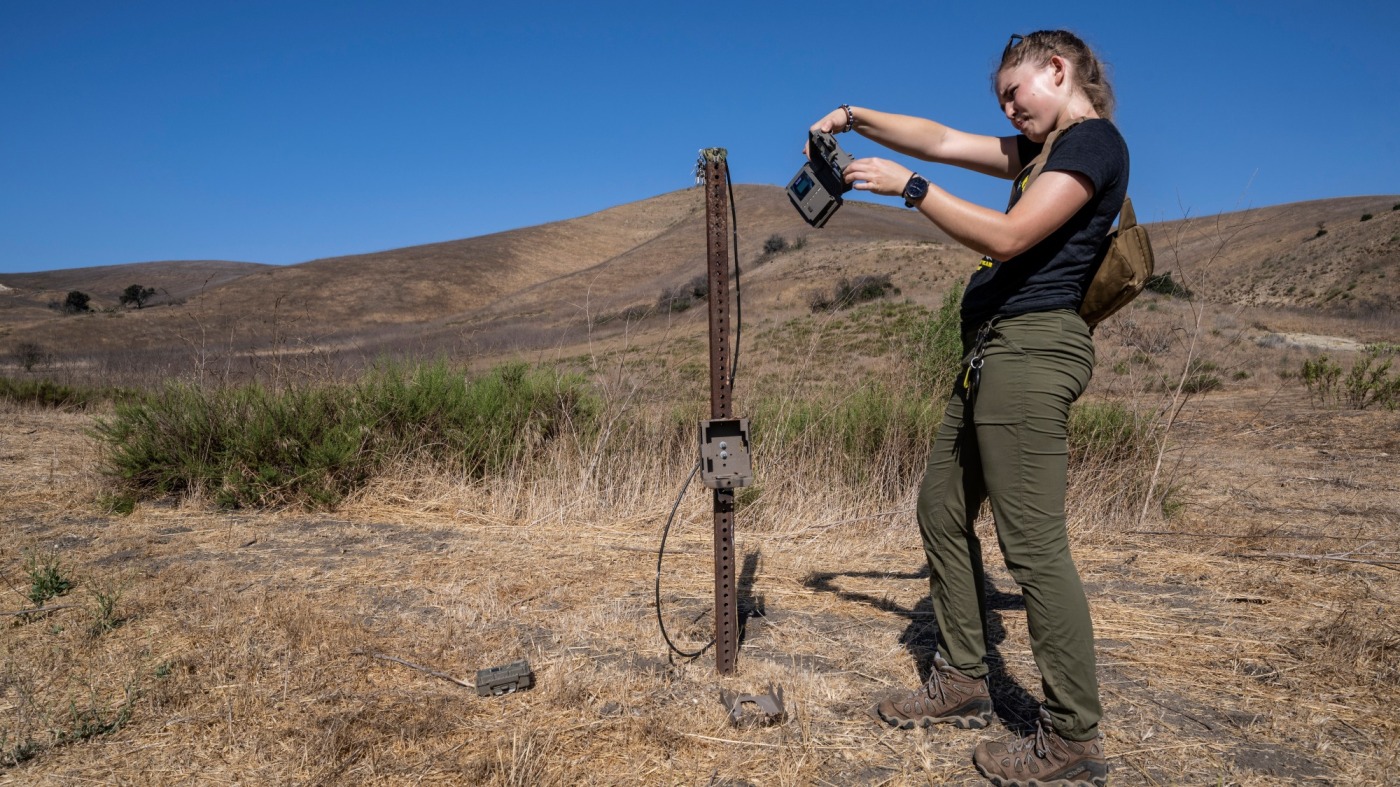A red-tailed hawk and two turkey vultures circled overhead as Erin Weiner walked down a dusty trail inside protected habitat land near Orange County’s Limestone Canyon.
Weiner, 24, is an avid hiker. The Long Beach resident is also a scientist. And on this trip she had a mission.
When Weiner reached a steel post sticking out of the tinder-dry brush she unlocked a metal box mounted near the top, brushed away a few dozen pincher bugs that had made the box their home, and popped out a simple trail camera. Inside the motion-triggered camera was a memory card with thousands of images taken over the past month — a jackpot for a biologist whose passion is wildlife conservation.
As she pursues her masters degree in biology at Cal State Long Beach, Weiner is studying stretches of eastern Orange County and the Santa Cruz Mountains that have been ravaged by wildfires in recent years. Her goal is to answer a series of questions that previously haven’t received much attention from researchers:
How long do mammals — from squirrels to deer to mountain lions — stay away from an area after a wildfire rips through? Where do they go in the meantime? Which animals come back first and why? And is there anything conservationists can do to help get wildlife, and therefore the entire ecosystem, back to normal faster?
There’s a reason there hasn’t been consistent research done on these questions, notes Ted Stankowich, a biology professor at Cal State Long Beach who’s advising Weiner’s project. That’s because getting answers requires a mix of advance preparation, patience, and the type of “luck” no one actually wants but clearly needs if they’re going to have solid data from “before,” “during” and “after” a wildfire.
The Irvine Ranch Conservancy, which manages more than 30,000 acres of urban wildlands in Orange County, has had dozens of trail cameras capturing wildlife in the canyon areas since 2007, said Nathan Gregory, who’s vice president of the nonprofit. To date, Gregory said, his agency’s understanding about how local wildlife responds to wildfires has been a mix of anecdotal evidence and assumptions. So he said the conservancy happily shared its archived footage with Weiner in hopes of getting hard science to explain animal behavior.
Cal State Long Beach’s Mammal Lab has had 13 of its own cameras in wildlands along Santiago Canyon Road since 2017, as part of a larger effort to study wildlife in urban areas. Combined, the cameras from the school and the conservancy give Weiner access to volumes of “before” data.
In late 2020, the Silverado and Bond fires tore through eastern Orange County, burning nearly 20,000 combined acres — including many areas covered by existing trail cameras. In a few cases, flames actually engulfed cameras. But while the devices were destroyed, a team from the Mammal Lab was able to recover data from the cameras’ memory cards, giving Weiner access to unique data from “during” a wildfire.
Shortly before the Bond fire hit, in December 2020, Weiner said a camera near Modjeska Canyon captured a fox nervously passing by. Then, when the blaze began, the fire itself triggered the camera, which snapped off three photos, each 10 seconds apart. The three images showed the flame sweeping in from the west, then engulfing the area, and finally moving out of frame. It took less than 30 seconds for the fire to consume the stretch of land in the camera’s 35-degree field of view.
Just a few hours after the fire passed, Weiner said the same camera captured a rabbit sitting on the site’s charred, ashy remains. That’s her first “after” shot. And she’s been collecting more of that “after” data ever since.
The Irvine Ranch Conservancy regularly passes along updated feeds from its cameras. To get recent photos from the Mammal Lab’s 13 cameras, Weiner takes a Cal State Long Beach vehicle out once a month, slings a worn fanny pack over one shoulder and hikes out to each site, swapping out rechargeable camera batteries and replacing full memory cards with blank ones.
Weiner then takes that data back to the Mammal Lab, where undergraduate students help her sort through and tag all of the captured images. The sorting work can be tedious, she said, since there are lots of false captures where the camera is triggered by blowing brush or a bird. But then there are moments when she sees a family of coyotes or a curious bobcat or stealthy mountain lion cross the frame, and Weiner said she gets inspired all over again.
There’s a similar situation up in the Santa Cruz Mountains.
The Wilmers Lab at UC Santa Cruz, where Weiner interned studying seals before starting her masters program at Cal State Long Beach, has had trail cameras in the area since 2014. In August 2020, the massive CZU Lightning Complex fire tore through the mountains. So, as part of her research, Weiner also is able to compare wildlife data from that area before and after the wildfire passed through.
Wildlife photos are only one piece of a complex puzzle Weiner is trying to put together, though.
For example, Weiner noted it can take seven years after a wildfire for plant life to fully regenerate. In the absence of native vegetation, invasive plants like mustard and wild oat can spread quickly. That’s not good for animals such as ground squirrels, which need open space to watch for and warn each other about predators. And because coyotes, foxes and bobcats all feed on ground squirrels, anything that hinders the prey population can be a struggle for those larger mammals.
To map out the chain of disruption, she plans to collect photos through December. Then she’ll start the analysis phase of the project, using open source data from agencies such as NASA and the Forest Service to layer in information about burn areas, elevation, precipitation and temperature. From there, she’ll try to draw conclusions about animal behavior that can help inform future wildlife management processes.
Irvine Ranch Conservancy hopes to use the information Weiner gathers, for example, to guide and prioritize habitat restoration projects, Gregory said.
That’s the goal driving Weiner, who’s been passionate about nature and wildlife since she was a kid in the Bay Area, exploring the outdoors as a Girl Scout and camping with her family.
As an undergraduate student at Cal Poly San Luis Obispo, Weiner helped study how road noise and artificial light impact development of bluebirds and how heat and oxygen levels impact barnacles. That final research was interrupted by the coronavirus pandemic, since she finished her undergraduate degree in spring 2020. So Weiner said she’s anxious to see this project through, with a goal of completing her wildfire research in the next couple of years before hopefully pursuing a career in wildlife management.
Fortunately, Weiner isn’t alone in this work.
With California facing more frequent and destructive wildfires due to climate change and outdated forest management practices, more attention is being paid to how massive blazes affect local ecosystems.
Chloe Nouzille, who is working on a masters at UCLA, is using trail cameras to study how wildlife in the Simi Hills and Santa Monica Mountains is recovering after the deadly Woolsey fire of 2018. And Kendall Calhoun, a PhD student at UC Berkeley, is researching the effects of fire and other climate change-driven events in the East Bay area.
Weiner is in touch with those fellow scientists. She said they each plan to publish their own research first, then hope to potentially combine forces and see what common threads they can parse out, with a shared goal of paining a broad picture of how wildfire affects California’s wildlife.
The public can help with these efforts in several ways, said Weiner’s adviser Stankowich.
Related Articles
McKinney Fire is ‘waking back up’ despite rain that poured over parts of the deadly blaze
2 bodies found in burned vehicle in California wildfire zone
Homeless warned to stay out of mountains and canyons as high fire threat looms
Bill to help West battle wildfires, drought wins House approval
Survey: Most Californians support taxing wealth, other big moves to fight climate change
The first is to leave any trail cameras you might stumble upon alone. Researchers lose a couple cameras each year to vandalism or theft, which he suspects sometimes happens when people are engaging in questionable behavior in the area then realize they might have been caught on film. But Stankowich said researchers immediately delete any images with people in them and don’t share them with anyone.
“We’re scientists, we’re not security,” Weiner said.
The public also can help by uploading their own wildlife images to iNaturalist, a website and app that catalogs animal sightings by citizen scientists around the world. While Weiner isn’t using data from that site for this project, Stankowich said researchers often do, and those images could help with future work in this area.


